In the United States, you can find about 30 venomous snake varieties nationwide. It is estimated by the CDC, that approximately 7000-8000 venomous snake bites occur every year, about 5 of those being fatal. Although, most venomous bites can have long-lasting complications, with victims continuing to suffer after they have survived treatment.
Snakes are the natural predators of small prey, like insects, birds, rodents, fish, and even some aquatic inhabitants, like frogs. They help keep those populations in natural balance with nature.
Keeping harmful snakes away starts with assessing the type of invasive snake you saw, and in turn, if you should use any defensive measures to protect your homestead.
Physical Properties
Head Shape
Although there is no single method of identifying a venomous snake. There are a few indicators that can help you assess a snake’s lethality. Some snakes can be categorized as venomous by the shape of their heads.
Non-venomous snakes tend to have rounded heads. The coral snake is the exception to that rule. The Coral Snake is the only venomous snake residing in the US that is not a pit viper. The Coral Snake has a rounded head. Differentiating the color bands on the snake can help you determine if the snake is the poisonous Coral Snake, or a non-venomous constrictor King Snake variety.
Snakes with a triangle head and 2 “pits” or holes on their snouts are classified as venomous. These pits aid to the term “pit vipers”, indicating a venomous species. The snake uses the pits to seek infrared radiation from prey.
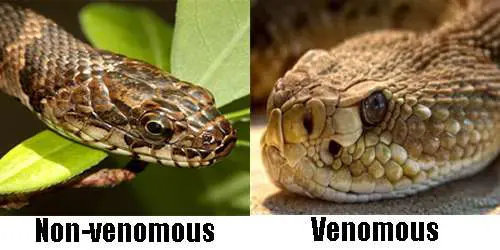
Pupils
The non-venomous varieties have round heads and round pupils. Pit vipers have thin, black pupils that are surrounded by yellow-green eyes. Also, they can be easily identified if you are close enough to see their eyes and heads.
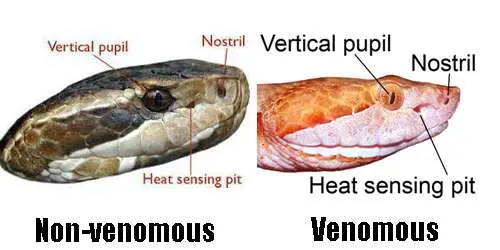
Coloring and Special Features
By combining your analysis of their eyes, and heads shapes, you can determine if their venom is toxic. Using any model to identify if their markings or color should only be considered for snakes that have profound markings, like the diamondback rattlesnake. Also, identifying potentially venomous snakes by only using their colors or markings is not an effective method to correctly classify the threat.
A special feature like a rattle can be a definite indicator, but not entirely accurate either. A bull snake can almost entirely convince a passerby that they are indeed the venomous rattlesnake. Their bites are painful, but not venomous or fatal.
Ensure you are factoring in all identifying methods to determine the snake’s true identity.
Common Trespassers
The Cottonmouth/Water Moccasin
This is a semi-aquatic snake. You will find them near freshwater sources hunting for their next meal. They can be destructive foes should you stumble upon one. They have been known to tear away flesh with their massive jowls. Also, their house has large venom glands that contain cytotoxic venom that can result in amputations or death for the victim. More than that, they have a strike range of ⅓-⅔ their body length away.
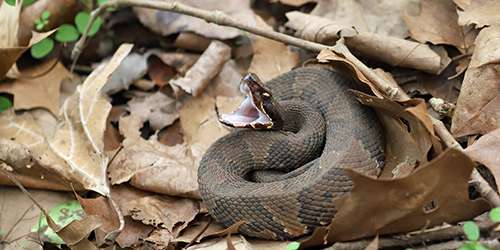
The Timber Rattlesnake
Can be found in almost any habitat. Lush forests, waterways, swamps, and even agricultural fields. They have large long fangs that deliver copious amounts of venom to the victim’s bloodstream. Also, they are however mildly tempered and sound off their rattle warning to warn possible threats from their paths. More than that, they have a strike range of ⅓ to ½ their body length.
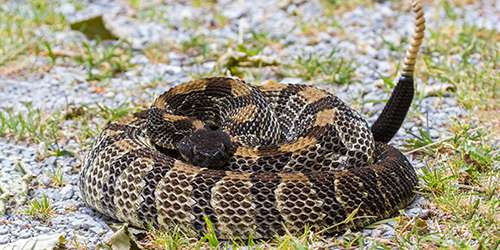
Black Diamond Rattlesnake
Found across western North America, the Black Diamond rattlesnake boasts a highly toxic venom that requires copious amounts of antivenom doses to treat the victim. The venom attacks nerve endings and causes excruciating pain to the unlucky recipient. They can strike to a range of over ⅔ their body lengths.
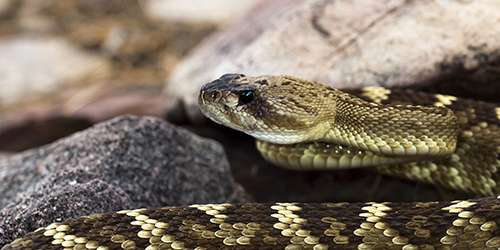
Copperhead Snake
A very aggressive species, the Copperhead is known to freeze when stumbled upon and enact a very defensive stance to warn potential threats. They do however have a weaker venom strength than other pit vipers. Copperhead rattlesnakes can strike up to half their body length.
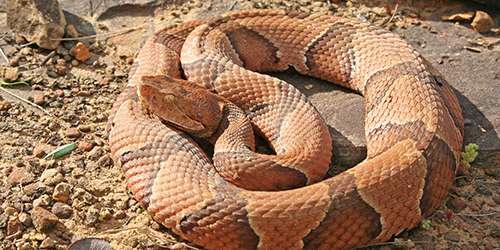
Eastern Coral Snake
A reclusive but deadly snake is the Eastern Coral Snake. They are one of the most dangerous animal inhabitants in the southwest. Eastern Coral Snakes have very little control of the volume of venom produced during each strike. Also, they have the potential to store enough venom to cause 5 human fatalities. This means one bite from them could mean death within 2 hours. These snakes can strike to ⅔ of their body length.
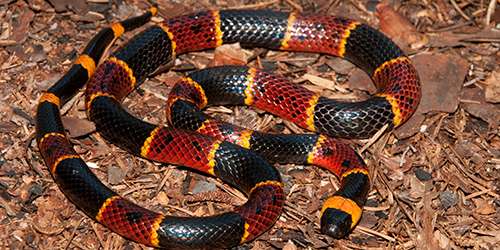
Tips to Keep Them Away from Your Property
Most snakes are active when temperatures are between 80-90 degrees. Hunting during the early mornings or late afternoons. They seek out areas that have a good population of their preferred prey. You can discourage them from hunting and inhabiting your property.
- Repair any cracks, or crevices are your home site. Snakes love to find these areas to cool off, hunt prey, or call their new den.
- Inspect areas where firewood or grain is stored. They also will slither right into a compost pile, or heaps of mulch or leaves. Ensure you keep any of their nesting favorites protected and cleared away.
- Consider installing snake-proof fencing along the perimeter of your homestead.
- Ensure any gardening areas have low grass, and no large holes for snakes to hide and settle in unnoticed.
Natural Deterrent Methods and Products
- Consider purchasing fox urine to deter venomous snakes from trespassing on your property. You can spray the properties area with the urine to mark the territory. Foxes, Guinea hens, turkeys, pigs, and cats are all excellent predators for snakes.
- Snakes have a super-human smell and do not like offending or intrusive odors. You can create a fire pit and add leaves or mulch to it. Essentially smothering the fire and smoking out the snakes. Forcing them to hunt elsewhere.
- Naphthalene; a commercially available snake repellent. It is composed of the same ingredients as mothballs. Without the toxicity to children or pets. It causes no harm to the snake; it is strictly an irritant. Most snakes will avoid the substance and move on.
- Sulfur; sprinkling sulfur powder around your property will cause any slithering snakes to suffer skin irritation along with an offending odor; to vacate your homesite promptly.
- Garlic and Onions contain sulfonic acid. This mild recipe will offend a snake’s sensitive smell receptors and discourage them from settling on your property. An easy formula; half the mixture of garlic and onions, the other half rock salt. 50:50. Spreading this mixture around your property will effectively dissuade the snake from further exploring your site. As well you can plant garlic, onions, lemongrass, and even marigolds to help keep the snakes away.
- Clove and Cinnamon concoction; Using a teaspoon of each and adding to 2 cups of water will create yourself a handy snake repellent. This can be used directly towards an approaching snake. It is not fatal to the snake but does come with the danger of a quickly fleeing snake. The applicant should have a clear indication of the direction of the fleeing snake to avoid being in the way.
- A vinegar solution mixed with water will effectively discourage a snake from further exploring your property. The acetic acid causes the snake’s ultra-sensitive sense of smell to become severely offended. This method is especially helpful around swampy or wet areas where semi-aquatic snakes are frequent.
Worst Case- Someone is Bitten
YES
- Identify the type of snake for medical personnel to properly provide the correct antivenom.
- Seek professional help immediately at the nearest hospital or clinic.
- Lay down or sit while keeping the bite wound below the heart level.
- Symptoms will be immediate and will become progressively worse. Some venomous snakes like the eastern Coral Snake have a delayed venom reaction; sometimes up to 18 hours after the victim was bitten.
- Remain calm, increasing your heart rate allows the venom to be quickly distributed throughout your nervous system.
- Venom begins shutting down our system within seconds of being bit. Some bites can be fatal within hours; so, it is advised to always seek medical attention as quickly as possible.
NO
- As venom breaks down the natural proteins that help our blood clot, it is advised to not use any blood-thinning pain medications to alleviate any pain.
- Try to capture or kill the snake. This could result in additional bites and is not necessary for the victim of the bite. Correctly identifying the snake is all that is needed.
- Suck out the venom. This will get you a mouth full of venom and is completely ineffective for removing venom from the already circulating system of the victim.
- Tourniquet the wound; this will essentially isolate the venom and the wound. Further complicates the severe reaction of the venom.
As there are over 30 different species of venomous snakes inhabiting the United States, it is advised to know how to effectively deter them from your property and what to do should you cross paths with one. It is safer for us and for the snake.
You may also like:
How to Prepare Your Homestead In Case Of a Natural Disaster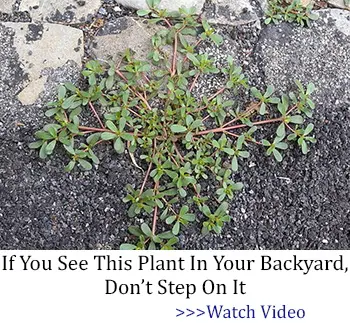
Do You Make These Fatal Mistakes in a Crisis? (Video)
11 Things That Won’t Lose Value In A Crisis
8 Best Natural Ways To Stop Slugs And Snails From Destroying Your Plants

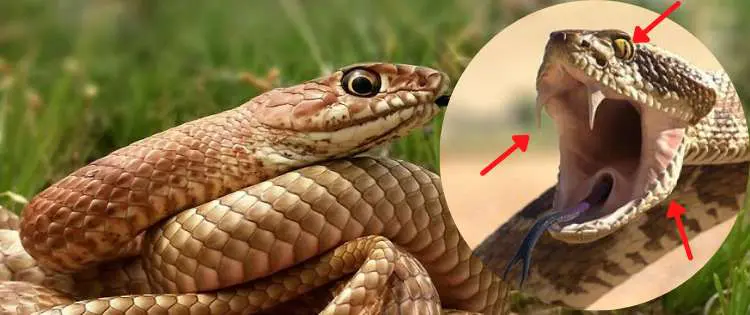








Your typographical errors on such a serious subject could cause someone great harm! Learn to proofread or simply stop spreading poorly conceived information.
Grammatical errors aside, great information. EASY to read and understand.
Copperhead Rattlesnake? No, copperheads are not rattlesnakes. That’s like saying copperhead water moccasin or rattlesnake water moccasin. Couple that with the very obvious other incorrect things and this makes for a poor article.
A statement was made at the starting few sentences, I’d like to bring to a point that every single post on identifying venomous and non-venomous snakes, that leaves a few that don’t fit into this teaching; and that is extremely dangerous.
“ A very clear indication you have a venomous snake in your sights is by the shape of their head. Non-venomous snakes have rounded heads. Venomous snakes have a triangle head with 2 “pits” or holes on their snouts. Also, these pits aid to the term “pit vipers”, indicating a venomous species.”
This is only partially true, there are a few deadly exceptions to this statement!!
Coral Snake is one that does not fit either of these, so then it must be non-venomous!?
Wrong! It, will keeeel!
Cobras, Mamba, Taipans, etc, just to name a few.
Don’t trust the above statement, if you don’t positively know the type of snake you are dealing with, leave it.
If you get bit, try to take a picture of it without getting bit again if possible.